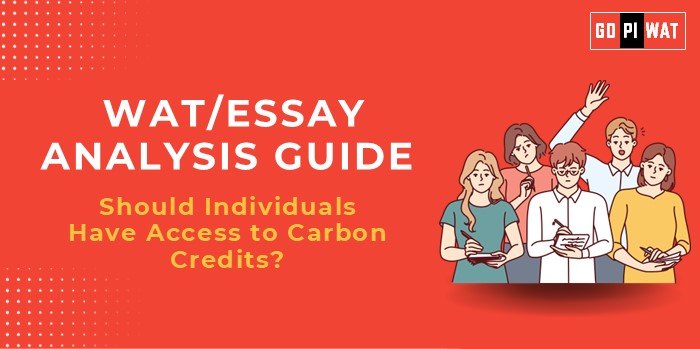📋 WAT/Essay Analysis Guide: Should Individuals Have Access to Carbon Credits?
🌍 Understanding the Topic’s Importance
Context Statement: As the world grapples with climate crises, integrating individuals into the carbon credit system could bridge the gap between policy and grassroots action, fostering comprehensive climate responsibility.
📝 Effective Planning and Writing
- Time Allocation: Reading & Planning: 5 min | Writing: 20 min | Review: 5 min.
- Preparation Tips: Research key statistics and case studies. Note stakeholders’ roles and potential outcomes.
✍️ Introduction Techniques for Essays
- Template A – Contrast Approach: “Corporations dominate the $851 billion carbon market, yet individuals, responsible for 20% of CO₂ emissions, remain sidelined. Is it time to rethink?”
- Template B – Solution-Based Approach: “Empowering individuals with carbon credits can democratize climate action and unlock untapped potential for emission reductions.”
📚 Structuring the Essay Body
- Achievements:
- Example: Sweden’s personal carbon incentives reduced emissions by 25%.
- Supporting Data: 20% of global CO₂ emissions stem from household activities.
- Challenges:
- Administrative hurdles (e.g., tracking small-scale credits).
- Inequality risks: Wealthier individuals might dominate credit usage.
- Future Outlook:
- Digital platforms could streamline individual participation.
- Policy frameworks to ensure equitable access.
🤝 Concluding Effectively
- Balanced Conclusion: “Individual carbon credits hold immense promise but require careful planning to avoid pitfalls and ensure equity.”
- Global Comparison Conclusion: “Learning from EU and Swedish initiatives, individual carbon credits could globalize inclusive climate solutions.”
📊 Analyzing Successes and Shortcomings
- Key Achievements: Potential to drive personal responsibility and market inclusivity.
- Ongoing Challenges: Equity concerns, greenwashing risks.
- Global Context: EU’s personal carbon allowance exploration.
💡 Recommendations for Sustainable Progress
- Tech Integration: Use blockchain for transparent tracking.
- Policy Support: Subsidize credits for low-income groups.
- Public Awareness: Campaigns to educate and engage citizens.
📖 Sample Short Essays
- Balanced Perspective: “While individual carbon credits can democratize climate action, challenges in equitable distribution must be addressed for widespread adoption.”
- Solution-Oriented: “Digital tools and inclusive policies can enable individuals to contribute effectively to carbon markets.”
- Global Comparison: “Drawing from Swedish and EU initiatives, individual access to carbon credits can amplify climate efforts worldwide.”


